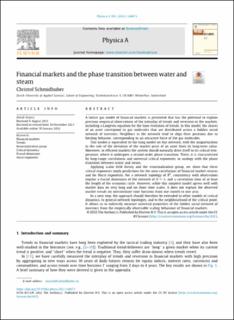Please use this identifier to cite or link to this item:
https://doi.org/10.21256/zhaw-24524Full metadata record
| DC Field | Value | Language |
|---|---|---|
| dc.contributor.author | Schmidhuber, Christof | - |
| dc.date.accessioned | 2022-03-10T15:09:13Z | - |
| dc.date.available | 2022-03-10T15:09:13Z | - |
| dc.date.issued | 2022-04-15 | - |
| dc.identifier.issn | 0378-4371 | de_CH |
| dc.identifier.issn | 1873-2119 | de_CH |
| dc.identifier.uri | https://digitalcollection.zhaw.ch/handle/11475/24524 | - |
| dc.description.abstract | A lattice gas model of financial markets is presented that has the potential to explain previous empirical observations of the interplay of trends and reversion in the markets, including a Langevin equation for the time evolution of trends. In this model, the shares of an asset correspond to gas molecules that are distributed across a hidden social network of investors. Neighbors in the network tend to align their positions due to herding behavior, corresponding to an attractive force of the gas molecules. This model is equivalent to the Ising model on this network, with the magnetization in the role of the deviation of the market price of an asset from its long-term value. Moreover, in efficient markets the system should naturally drive itself to its critical temperature, where it undergoes a second-order phase transition. There, it is characterized by long-range correlations and universal critical exponents, in analogy with the phase transition between water and steam. Applying scalar field theory and the renormalization group, we show that these critical exponents imply predictions for the auto-correlations of financial market returns and for Hurst exponents. For a network topology of R^D, consistency with observation implies a fractal dimension of the network of D close to 3, and a correlation time of at least the length of the economic cycle. However, while this simplest model agrees well with market data on very long and on short time scales, it does not explain the observed market trends on intermediate time horizons from one month to one year. In a next step, the approach should therefore be extended to other models of critical dynamics, to general network topologies, and to the neighbourhood of the critical point. It allows us to indirectly measure universal properties of the hidden social network of investors from the empirically observable scaling behaviour of financial markets. | de_CH |
| dc.language.iso | en | de_CH |
| dc.publisher | Elsevier | de_CH |
| dc.relation.ispartof | Physica A: Statistical Mechanics and its Applications | de_CH |
| dc.rights | http://creativecommons.org/licenses/by/4.0/ | de_CH |
| dc.subject | Financial market | de_CH |
| dc.subject | Trend | de_CH |
| dc.subject | Renormalization group | de_CH |
| dc.subject | Critical dynamics | de_CH |
| dc.subject | Fractal dimension | de_CH |
| dc.subject | Hurst exponent | de_CH |
| dc.subject.ddc | 332: Finanzwirtschaft | de_CH |
| dc.title | Financial markets and the phase transition between water and steam | de_CH |
| dc.type | Beitrag in wissenschaftlicher Zeitschrift | de_CH |
| dcterms.type | Text | de_CH |
| zhaw.departement | School of Engineering | de_CH |
| zhaw.organisationalunit | Institut für Datenanalyse und Prozessdesign (IDP) | de_CH |
| dc.identifier.doi | 10.1016/j.physa.2022.126873 | de_CH |
| dc.identifier.doi | 10.21256/zhaw-24524 | - |
| zhaw.funding.eu | No | de_CH |
| zhaw.issue | 126873 | de_CH |
| zhaw.originated.zhaw | Yes | de_CH |
| zhaw.publication.status | publishedVersion | de_CH |
| zhaw.volume | 592 | de_CH |
| zhaw.publication.review | Peer review (Publikation) | de_CH |
| zhaw.funding.snf | 190659 | de_CH |
| zhaw.author.additional | No | de_CH |
| zhaw.display.portrait | Yes | de_CH |
| Appears in collections: | Publikationen School of Engineering | |
Files in This Item:
| File | Description | Size | Format | |
|---|---|---|---|---|
| 2022_Schmidhuber_Financial-markets-phase-transition-water-steam.pdf | 2.25 MB | Adobe PDF |  View/Open |
Show simple item record
Schmidhuber, C. (2022). Financial markets and the phase transition between water and steam. Physica A: Statistical Mechanics and Its Applications, 592(126873). https://doi.org/10.1016/j.physa.2022.126873
Schmidhuber, C. (2022) ‘Financial markets and the phase transition between water and steam’, Physica A: Statistical Mechanics and its Applications, 592(126873). Available at: https://doi.org/10.1016/j.physa.2022.126873.
C. Schmidhuber, “Financial markets and the phase transition between water and steam,” Physica A: Statistical Mechanics and its Applications, vol. 592, no. 126873, Apr. 2022, doi: 10.1016/j.physa.2022.126873.
SCHMIDHUBER, Christof, 2022. Financial markets and the phase transition between water and steam. Physica A: Statistical Mechanics and its Applications. 15 April 2022. Bd. 592, Nr. 126873. DOI 10.1016/j.physa.2022.126873
Schmidhuber, Christof. 2022. “Financial Markets and the Phase Transition between Water and Steam.” Physica A: Statistical Mechanics and Its Applications 592 (126873). https://doi.org/10.1016/j.physa.2022.126873.
Schmidhuber, Christof. “Financial Markets and the Phase Transition between Water and Steam.” Physica A: Statistical Mechanics and Its Applications, vol. 592, no. 126873, Apr. 2022, https://doi.org/10.1016/j.physa.2022.126873.
Items in DSpace are protected by copyright, with all rights reserved, unless otherwise indicated.